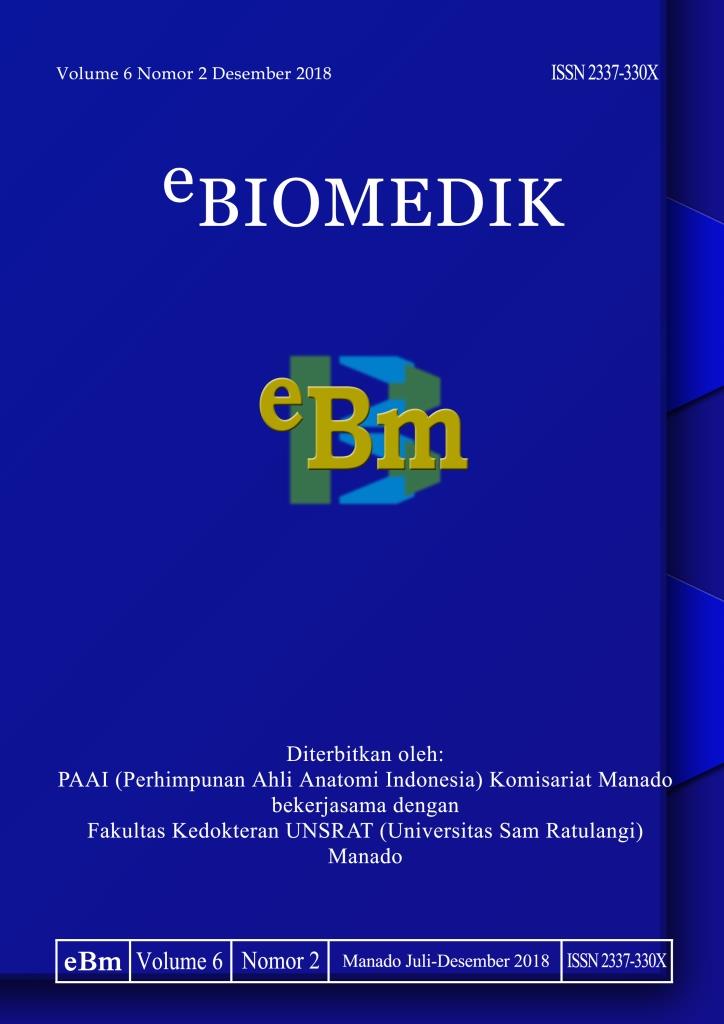Isolasi Bakteri Resisten Arsen pada Sedimen Tanah di Muara Sungai Buyat
DOI:
https://doi.org/10.35790/ebm.v6i2.21994Abstract
Abstract: Arsenic, a toxic element to the body, is commonly found in mining waste. Buyat is known as a mining location (especially gold mine) which dumps mining waste in the form of tailings into the sea through the Buyat River. A mine should process the degradation of waste from a very toxic form into a less toxic form before disposing the waste into the sea. However, this process is often overlooked by artisanal miner because it consumes considerable production cost. Waste containing toxic arsenic gradually accumulates into sediments in the ocean, so bacteria in the environment begin to develop a mechanism of resistance to arsenic. This study was aimed to determine the types of arsenic-resistant bacteria isolated from sediment at Buyat estuary using conventional bacterial identification methods, including morpho-logical, physiological, and biochemical tests. Nine bacterial isolates were treated with arsenic stress at 5 ppm, 10 ppm, 20 ppm, 40 ppm, 80 ppm, 100 ppm, 300 ppm, 500 ppm, and 1000 ppm. The results showed several bacteria that could grow even in conditions containing as much as 1000 ppm of arsenic, namely Klebsiella, Staphylococcus, Aeromonas, Clostridium, Bacillus, Hafnia, and Escherichia. Conclusion: In the sediment of Buyat estuary we found seven genera of bacteria, as follows: Klebsiella, Staphylococcus, Aeromonas, Clostridium, Bacillus, Hafnia and Escherichia.
Keywords: Arsenic-resistant bacteria, Buyat River, sediment, As2O3
Abstrak: Arsen ialah salah satu jenis unsur yang bersifat toksik bagi tubuh dan merupakan salah satu hasil limbah pertambangan. Buyat merupakan salah satu lokasi pertambangan (terutama tambang emas) yang membuang limbah pertambangannya berupa tailings ke laut. Limbah tersebut dialirkan melalui Sungai Buyat. Pertambangan yang resmi harus melakukan proses degradasi arsen dari yang sangat toksik menjadi kurang toksik terlebih dahulu sebelum membuang limbah ke laut, namun proses ini sering diabaikan oleh pertambangan rakyat karena memakan biaya produksi yang cukup besar. Limbah yang mengandung arsen toksik lama-kelamaan terakumulasi menjadi sedimen di laut, sehingga bakteri di lingkungan tersebut mulai mengembangkan mekanisme resistensi terhadap arsen. Penelitian ini bertujuan untuk mengetahui jenis bakteri resisten arsen yang diisolasi dari sedimen di muara Sungai Buyat menggunakan metode identifikasi bakteri konvensional. Terdapat 9 isolat bakteri yang diberi perlakuan stres arsen pada 5 ppm, 10 ppm, 20 ppm, 40 ppm, 80 ppm, 100 ppm, 300 ppm, 500 ppm, dan 1000 ppm. Hasil penelitian mendapatkan beberapa jenis bakteri yang dapat bertumbuh bahkan pada kondisi mengandung arsen sebanyak 1000 ppm, yaitu genus Klebsiella, Staphylococcus, Aeromonas, Clostridium, Bacillus, Hafnia, dan Escherichia. Simpulan: Pada sedimen tanah di muara Sungai Buyat diidentifikasi tujuh genus bakteri, yaitu Klebsiella, Staphylococcus, Aeromonas, Clostridium, Bacillus, Hafnia, dan Escherichia.
Kata kunci: bakteri resisten arsen, Sungai Buyat, sedimen, As2O3





